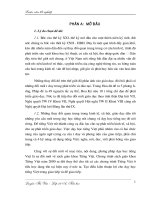Giao tiếp trong lớp học Communication in classroom
Bạn đang xem bản rút gọn của tài liệu. Xem và tải ngay bản đầy đủ của tài liệu tại đây (277.94 KB, 17 trang )
Communication in the
Classroom
Jane Patton, Ed. D.
Communication Studies Faculty
Your typical class. . .
First 5 min.
____
____
____
Conclusion
Instruction depends upon
communication
Your communication
Students’ communication
---with you & classmates
Class climate
Help
Hurt
Kinds of classroom
communication
Presentations, lectures
Group work
Interpersonal
Intercultural
Tips for Effective
Presentations
Know your audience
Express ideas clearly & explicitly
Check audience’s listening skills
Gain & keep attention
Be well organized & prepared
Use visual aids effectively
Remember messages are verbal, visual and vocal
Effective visual aids
Can be understood in 6 seconds
Anchor listeners to the key concepts
Do not put audience in reading mode
Enhance (aid) your verbal & vocal messages
C. Hamilton
Benefits of visual aids
Audience Recall
Verbal
only
Visual
only
70%
10%
72%
20%
Verbal
and
Visual
After 3 hours
85%
65%
After 3 days
C. HAMILTON
Don McMillan
/>eaction=vids.individual&videoID=15296
37984
Or google: Life after Death by PowerPoint
Group Communication Skills
(students need to learn them)
Speak clearly & succinctly
Encourage others to speak
Don’t monopolize
Listen well; paraphrase
Stick to topic/task
Human relations skills
Interpersonal
Communication
Listen; give attention
Paraphrase & summarize
Define terms
Build rapport; trust
Show empathy; respect
Remember messages are verbal, visual,
vocal
Class Climates (Gibb categories)
DEFENSIVE
SUPPORTIVE
1. Evaluation
1. Description
2. Control
2. Problem Orientation
3. Strategy
3. Spontaneity
4. Neutrality
4. Empathy
5. Superiority
5. Equality
6. Certainty
6. Provisionalism
Intercultural Principles
Successful comm. depends upon shared meanings.
Cultural patterns: the group’s collective beliefs, values,
norms
One’s culture & language affects one’s cognition & learning
Native language affects one’s world view, beliefs, etc.
Different cultural practices in education
Differences continuum: minor to major.
Self Reflection Activity
Our Challenge:
To model and teach
effective
communication in our
classrooms









